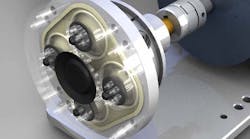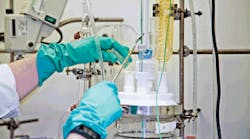It’s no secret that in pharma, consistency is king. When it comes to fluid handling, manufacturers need components that will churn out reliable and safe results. But there are also opportunities to maximize this critical area of operations to boost speed, increase efficiency and control costs.
As pharma companies look for ways to optimize fluid handling, vendors have stepped up to innovate solutions to help them achieve better results.
Continuous processing
For years, pharma companies have been looking for more ways to transition parts of their operations into continuous manufacturing, and that trend is showing no signs of abating. Switching to continuous processing provides several key benefits to manufacturers.
“Traditionally, virtually all big pharma manufacturing operations have used the tried and tested batch approach to meet regulatory requirements for good manufacturing practice (GMP),” says Jim Sanford, senior product manager of Fluid Paths at Watson-Marlow. “However, continuous processing has the potential to improve efficiency by decreasing processing times, eliminating unnecessary steps and streamlining the entire process, as well as increasing drug quality by reducing batch-to-batch variability. As a result, we are seeing growing demand for certified solutions for continuous processing.”
Saint-Gobain’s ValPlus family of products provides a higher level of quality assurance.
With that goal in mind, Watson-Marlow has developed a range of fluid components the company says can be easily assembled into a complete manufacturing processes for end-to-end fluid management.
“For example, our BioPure range offers FDA-compliant gaskets and connectors in a range of materials to satisfy GMP requirements and facilitate process validation,” Sanford explains.
The company’s BioPure gasket range was developed with materials such as polytetrafluoroethylene, a synthetic rubber and fluoropolymer elastomer to ensure chemical and steam resistance. The components also support leak resistant connectivity within pharmaceutical and biotechnology production processes, which reduces validation risks in contamination-free applications.
“The new range of materials offered will provide our customers with greater choice to design fluid paths that satisfy their production needs,” says Mark Lovallo, product manager of Watson-Marlow.
Safeguarding cells
As pharma companies look for ways to boost efficiency, there has also been an increased emphasis on improving cell viability.
“The demand for greater production efficiency is driving manufacturers to maximize cell viability throughout their processes,” says Phil Nyren, product manager, Fluid Handling, Cole-Parmer.
According to Nyren, companies are specifically looking for ways to reduce the amount of shear in fluid systems, which can be accomplished in a few ways.
“The first option is to decrease the speed of the pump to reduce the damaging forces placed on the cell suspension. Flow rates can be maintained at reduced speed by increasing the tube diameter in the fluid system. Another way is to specify a pump with low-shear characteristics,” Nyren says.
Cole-Parmer’s Masterflex peristaltic pumps have improved performance in applications involving live cells and other shear-sensitive fluids.
To that end, Masterflex Cytoflow pump systems by Cole-Parmer feature convex rollers with a concave occlusion surface that limits shear as the tubing is progressively occluded. The company says that the introduction of convex rollers in Masterflex peristaltic pumps has also improved performance in applications involving live cells and other shear-sensitive fluids.
Contamination control
The integration of single-use components also continues to be an effective way for manufacturers to limit contamination risks.
“As this trend continues to develop, pharmaceutical manufacturers are requesting single-use system manufacturers to provide assurance that their single-use products are in compliance with current good manufacturing practices and do not alter the drug products beyond established regulatory requirements,” explains Aaron Updegrove, marketing director of Bioprocess Solutions at Saint-Gobain.
But according to Updegrove, tubing products are still rarely certified to meet endotoxin, bioburden and particulate standards.
“In some cases, pharmaceutical manufacturers have taken their own risk mitigation measures to reduce potential contamination such as rinsing tubing products with water for injection. However, these strategies are costly and in some cases, infeasible,” Updegrove explains.
Updegrove says that Saint-Gobain Life Sciences’ ValPlus products provide pharma manufacturers with an enhanced level of tubing certification and confidence in the cleanliness of the tubing products they use in critical applications. This enhanced documentation is available for a variety of Saint-Gobain tubing brands including C-Flex and Sani-Tech, and provides certification to USP <788> for particulate, USP <85> for bacterial endotoxin, and ISO 11737 for bacterial and fungal bioburden.
“This higher level of quality assurance is an industry-leading effort to quantify and reduce risks associated with fluid path contamination,” Updegrove says.
Ultimately, vendors are showing that manufacturers can find plenty of pathways to reducing costs and improving efficiency in their tubing and fluid control systems.





